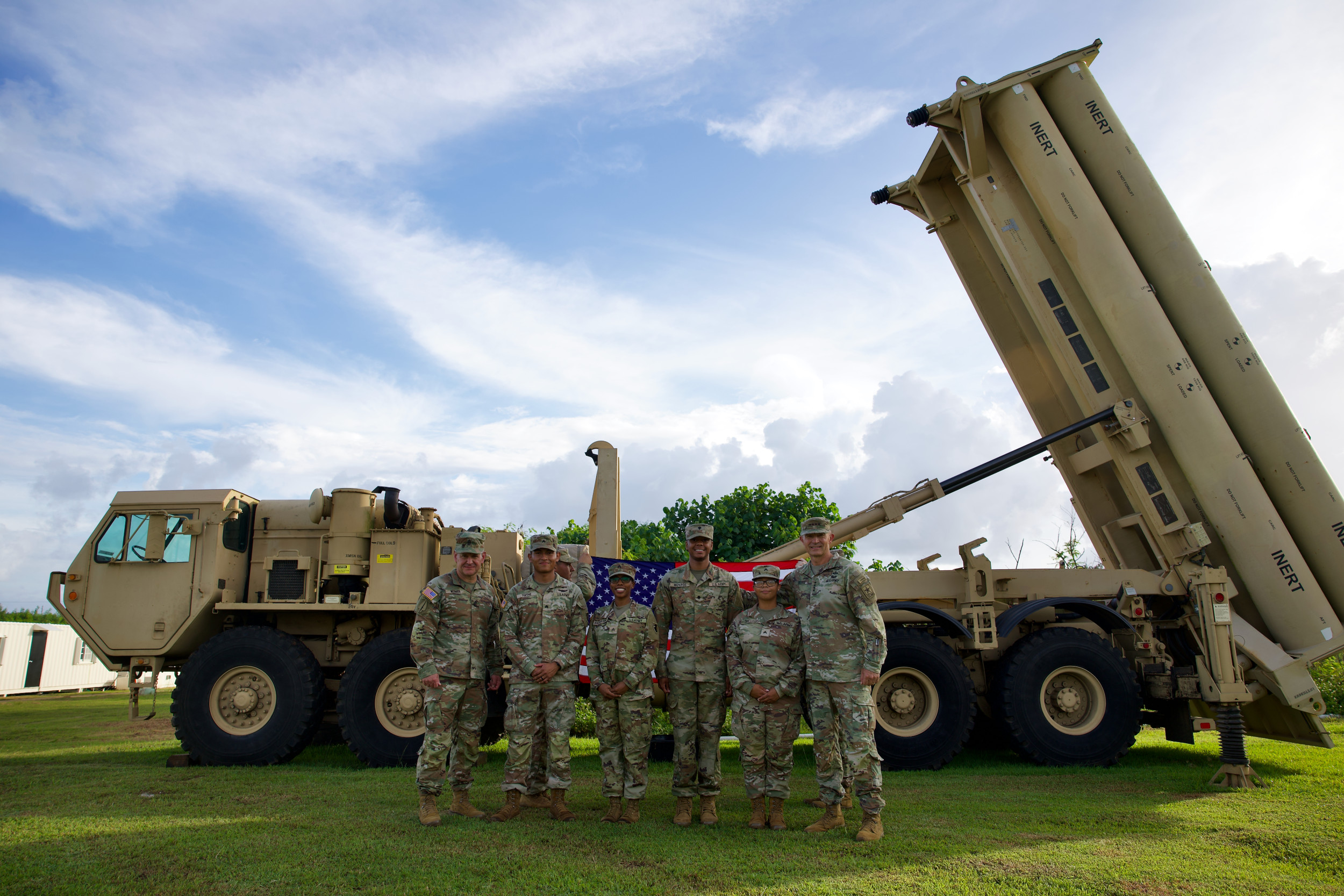Jun 27, 2025
The U.S. drew down a significant portion of its advanced anti-missile system to bolster Israel's defense against Iranian aerial attacks during a 12-day conflict in which Israel and the U.S. struck nuclear facilities and Iran retaliated with missile launches, according to defense news outlets and independent analysts.
The Pentagon press office told Newsweek "we have nothing to provide".
Why It Matters
Israel has long relied on the Lockheed Martin developed Terminal High-Altitude Area Defense, known as the THAAD battery, for shielding against ballistic missiles from Iran or its proxy groups such as the Yemeni Houthis.
The U.S. military operates seven THAAD batteries. An eighth, getting integrated into the Missile Defense Agency, is capable of tracking hypersonic missiles. The THAAD deployment to Israel is part of a broader challenge where supporting allies in conflict zones means using resources that could affect military
readiness and future deployment.
What To Know
During the recent Israel-Iran conflict, the United States used an estimated 15 to 20 percent of its global THAAD missile interceptor stockpile, incurring unprecedented costs exceeding $800 million, according to the Bulgarian Military News and Military Watch Magazine outlets.
Iran launched a major missile barrage on cities across Israel in response to attacks on its nuclear and military targets, prompting residents to seek shelter amid nationwide. They included older models such as the Ghadr and Emad, the medium-range Kheibar Shekan and the Fattah-1 hypersonic missile—which travels at up to Mach 15 and is hard to intercept.
The U.S. restocked interceptor missiles for the THAAD system it deployed in Israel in 2024, amid concerns of shortage, The Wall Street Journal reported. A single THAAD interceptor costs about $12-15 million, according to estimates by multiple defense and news outlets.
While the battery costs approximately $1.3 billion, the interceptor cost estimation for 2025 is $18 million for production only, increasing to $27 million with RDT&E (research, development, test, and evaluation) included, Sidharth Kaushal, Senior Research Fellow specializing in Sea Power within the Military Sciences division at the Royal United Services Institute (RUSI) told Newsweek.
One open-intelligence analyst on X, formerly Twitter, estimated that the value of THAAD missiles used in the conflict exceeded $498 million.
The system intercepts short- to intermediate-range ballistic missiles in their terminal phase—just before impact. It covers a larger area than U.S.-made Patriot missile system and comprises a launcher, interceptor, radar, and fire control unit.
The American THAAD system deployed to Israel failed to intercept Houthi missiles on two occasions in May. In one case, the projectile was brought down by Israel's Arrow long-range defense system; in the other, a missile struck near Tel Aviv's Ben Gurion International Airport.
The U.S. also used the Patriot system and a Navy destroyer to help Israel shoot down incoming ballistic missiles from Iran, according to The Associated Press. Israel also has the Iron Dome system for protection from short-range artillery and rockets, such as those fired by Hamas and other Palestinian factions in the Gaza Strip.
As a series of direct confrontations escalated in 2024, Iran fired hundreds of ballistic missiles towards Israel, with the Pentagon saying it was deploying to Israel its advanced system battery to Israel, along some 100 U.S. troops.
What People Are Saying
Tom Karako, director of the Missile Defense Project at the Center for Strategic and International Studies (CSIS) told The Wall Street Journal during the conflict: "Neither the U.S. nor the Israelis can continue to sit and intercept missiles all day. The Israelis and their friends need to move with all deliberate haste to do whatever needs to be done, because we cannot afford to sit and play catch."
User @MenchOsint, an independent open-intelligence and military analyst wrote on X: "Moral of the story: After all these decades, Israel can't win a war without US direct support. Six-days war: US imposes embargo on arms on the region but secretly help Israel. Twelve-days war: US imposes sanctions on Iran & help Israel with Defense (THAAD) direct strikes, intelligence & arms supplies."
User @AirPowerNEW1, an independent open-source analyst on X: "Assuming the US Army THAAD battery in Israel used up 50% more interceptors (39+20) than the video evidence used shows, it would mean roughly 10-15% of the US Army's inventory of THAAD missiles was likely used up over this 12 day period. While US Army has been buying small number of THAAD AURs lately to allow production deliveries to FMS customers, this could force some interesting discussions with KSA, UAE and future customers (Qatar)."
What Happens Next
Urgent restocking and manufacturing of THAAD interceptors will be needed, not only for Israel but for other regions where they may be required, such as in the wider Middle East, the Pacific and Europe.

 www.newsweek.com
www.newsweek.com
The U.S. drew down a significant portion of its advanced anti-missile system to bolster Israel's defense against Iranian aerial attacks during a 12-day conflict in which Israel and the U.S. struck nuclear facilities and Iran retaliated with missile launches, according to defense news outlets and independent analysts.
The Pentagon press office told Newsweek "we have nothing to provide".
Why It Matters
Israel has long relied on the Lockheed Martin developed Terminal High-Altitude Area Defense, known as the THAAD battery, for shielding against ballistic missiles from Iran or its proxy groups such as the Yemeni Houthis.
The U.S. military operates seven THAAD batteries. An eighth, getting integrated into the Missile Defense Agency, is capable of tracking hypersonic missiles. The THAAD deployment to Israel is part of a broader challenge where supporting allies in conflict zones means using resources that could affect military
readiness and future deployment.
What To Know
During the recent Israel-Iran conflict, the United States used an estimated 15 to 20 percent of its global THAAD missile interceptor stockpile, incurring unprecedented costs exceeding $800 million, according to the Bulgarian Military News and Military Watch Magazine outlets.
Iran launched a major missile barrage on cities across Israel in response to attacks on its nuclear and military targets, prompting residents to seek shelter amid nationwide. They included older models such as the Ghadr and Emad, the medium-range Kheibar Shekan and the Fattah-1 hypersonic missile—which travels at up to Mach 15 and is hard to intercept.
The U.S. restocked interceptor missiles for the THAAD system it deployed in Israel in 2024, amid concerns of shortage, The Wall Street Journal reported. A single THAAD interceptor costs about $12-15 million, according to estimates by multiple defense and news outlets.
While the battery costs approximately $1.3 billion, the interceptor cost estimation for 2025 is $18 million for production only, increasing to $27 million with RDT&E (research, development, test, and evaluation) included, Sidharth Kaushal, Senior Research Fellow specializing in Sea Power within the Military Sciences division at the Royal United Services Institute (RUSI) told Newsweek.
One open-intelligence analyst on X, formerly Twitter, estimated that the value of THAAD missiles used in the conflict exceeded $498 million.
The system intercepts short- to intermediate-range ballistic missiles in their terminal phase—just before impact. It covers a larger area than U.S.-made Patriot missile system and comprises a launcher, interceptor, radar, and fire control unit.
The American THAAD system deployed to Israel failed to intercept Houthi missiles on two occasions in May. In one case, the projectile was brought down by Israel's Arrow long-range defense system; in the other, a missile struck near Tel Aviv's Ben Gurion International Airport.
The U.S. also used the Patriot system and a Navy destroyer to help Israel shoot down incoming ballistic missiles from Iran, according to The Associated Press. Israel also has the Iron Dome system for protection from short-range artillery and rockets, such as those fired by Hamas and other Palestinian factions in the Gaza Strip.
As a series of direct confrontations escalated in 2024, Iran fired hundreds of ballistic missiles towards Israel, with the Pentagon saying it was deploying to Israel its advanced system battery to Israel, along some 100 U.S. troops.
What People Are Saying
Tom Karako, director of the Missile Defense Project at the Center for Strategic and International Studies (CSIS) told The Wall Street Journal during the conflict: "Neither the U.S. nor the Israelis can continue to sit and intercept missiles all day. The Israelis and their friends need to move with all deliberate haste to do whatever needs to be done, because we cannot afford to sit and play catch."
User @MenchOsint, an independent open-intelligence and military analyst wrote on X: "Moral of the story: After all these decades, Israel can't win a war without US direct support. Six-days war: US imposes embargo on arms on the region but secretly help Israel. Twelve-days war: US imposes sanctions on Iran & help Israel with Defense (THAAD) direct strikes, intelligence & arms supplies."
User @AirPowerNEW1, an independent open-source analyst on X: "Assuming the US Army THAAD battery in Israel used up 50% more interceptors (39+20) than the video evidence used shows, it would mean roughly 10-15% of the US Army's inventory of THAAD missiles was likely used up over this 12 day period. While US Army has been buying small number of THAAD AURs lately to allow production deliveries to FMS customers, this could force some interesting discussions with KSA, UAE and future customers (Qatar)."
What Happens Next
Urgent restocking and manufacturing of THAAD interceptors will be needed, not only for Israel but for other regions where they may be required, such as in the wider Middle East, the Pacific and Europe.

US missile defenses heavily depleted in shielding Israel: report
Dozens of THAAD missile interceptors are estimated to have been used to counter Iran's barrage attacks on Israel






